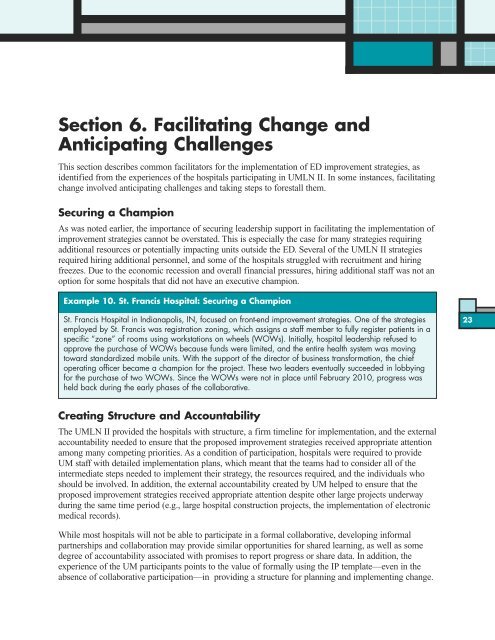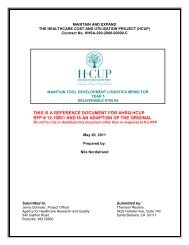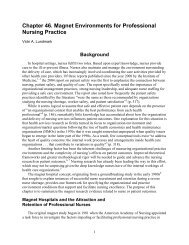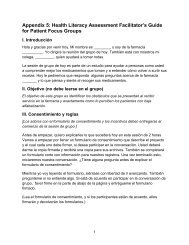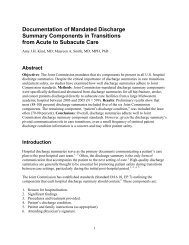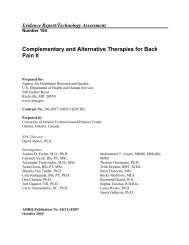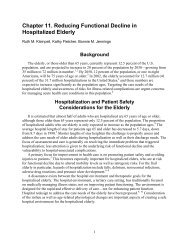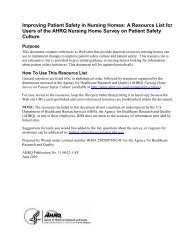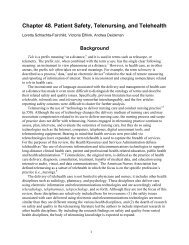Improving Patient Flow and Reducing Emergency Department ...
Improving Patient Flow and Reducing Emergency Department ...
Improving Patient Flow and Reducing Emergency Department ...
Create successful ePaper yourself
Turn your PDF publications into a flip-book with our unique Google optimized e-Paper software.
Section 6. Facilitating Change <strong>and</strong><br />
Anticipating Challenges<br />
This section describes common facilitators for the implementation of ED improvement strategies, as<br />
identified from the experiences of the hospitals participating in UMLN II. In some instances, facilitating<br />
change involved anticipating challenges <strong>and</strong> taking steps to forestall them.<br />
Securing a Champion<br />
As was noted earlier, the importance of securing leadership support in facilitating the implementation of<br />
improvement strategies cannot be overstated. This is especially the case for many strategies requiring<br />
additional resources or potentially impacting units outside the ED. Several of the UMLN II strategies<br />
required hiring additional personnel, <strong>and</strong> some of the hospitals struggled with recruitment <strong>and</strong> hiring<br />
freezes. Due to the economic recession <strong>and</strong> overall financial pressures, hiring additional staff was not an<br />
option for some hospitals that did not have an executive champion.<br />
Example 10. St. Francis Hospital: Securing a Champion<br />
St. Francis Hospital in Indianapolis, IN, focused on front-end improvement strategies. One of the strategies<br />
employed by St. Francis was registration zoning, which assigns a staff member to fully register patients in a<br />
specific “zone” of rooms using workstations on wheels (WOWs). Initially, hospital leadership refused to<br />
approve the purchase of WOWs because funds were limited, <strong>and</strong> the entire health system was moving<br />
toward st<strong>and</strong>ardized mobile units. With the support of the director of business transformation, the chief<br />
operating officer became a champion for the project. These two leaders eventually succeeded in lobbying<br />
for the purchase of two WOWs. Since the WOWs were not in place until February 2010, progress was<br />
held back during the early phases of the collaborative.<br />
Creating Structure <strong>and</strong> Accountability<br />
The UMLN II provided the hospitals with structure, a firm timeline for implementation, <strong>and</strong> the external<br />
accountability needed to ensure that the proposed improvement strategies received appropriate attention<br />
among many competing priorities. As a condition of participation, hospitals were required to provide<br />
UM staff with detailed implementation plans, which meant that the teams had to consider all of the<br />
intermediate steps needed to implement their strategy, the resources required, <strong>and</strong> the individuals who<br />
should be involved. In addition, the external accountability created by UM helped to ensure that the<br />
proposed improvement strategies received appropriate attention despite other large projects underway<br />
during the same time period (e.g., large hospital construction projects, the implementation of electronic<br />
medical records).<br />
While most hospitals will not be able to participate in a formal collaborative, developing informal<br />
partnerships <strong>and</strong> collaboration may provide similar opportunities for shared learning, as well as some<br />
degree of accountability associated with promises to report progress or share data. In addition, the<br />
experience of the UM participants points to the value of formally using the IP template—even in the<br />
absence of collaborative participation—in providing a structure for planning <strong>and</strong> implementing change.<br />
23


